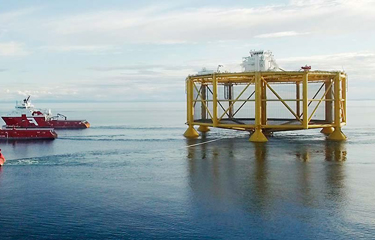Limited opportunities to secure new salmon farming licenses in Norway and a lack of coastal space in China have made offshore aquaculture an increasingly attractive means for these two nations to increase their future fish production and meet the growing demand for marine proteins, according to a new analysis from Rabobank.
According to RaboResearch’s “A Deep Dive into Offshore Aquaculture,” released on 9 September, those limits on the sector are “supercharging innovation and scale,” with many new offshore projects in the pipeline, particularly in Norway.
Compiled by Rabobank Senior Global Seafood Specialist Gorjan Nikolik, the study suggests the salmon-farming sector’s transition into offshore aquaculture is a “natural evolution” of its current business model, providing the scope to generate a gradual, longer-term increase in supply.
It notes that in Norway, which accounts for just under half of Atlantic salmon production globally, scant new licenses can be acquired, with the system designed to prevent uncontrolled growth – allowing for a theoretical maximum 6 percent increase every two years. In using offshore for the final stage of grow-out (for fish weighing 2.5 to 6 kilograms) and maintaining the initial stages in existing coastal sites and land-based systems, Rabobank suggests that salmon farmers can ensure more growth potential.
The Norwegian government has been supportive of such moves through the granting of development licenses. More than 200 projects have been proposed so far, with 70 accepted by the state. Current expectations are that Norway can produce more than 100,000 metric tons (MT) of salmon in offshore systems by 2030, the report states, adding that many of the same offshore drivers apply in other salmon-farming regions, such as Scotland, Canada, Chile, the Faroe Islands, and Australia.
In regard to fish welfare, the report finds salmon raised in offshore locations enjoy strong currents, more stable temperatures, and are confronted by fewer biological challenges, including parasites like sea lice.
Meanwhile, China, described as the “second and parallel epicenter of offshore aquaculture innovation,” is hindered by a dearth of suitable coastal sites to farm in, the report found.
The world’s largest seafood consumer accounts for almost 60 percent of the world’s farmed seafood production, and while most of this is freshwater and mollusk aquaculture (carp and mussels, respectively), the country’s finfish production is a large and rapidly expanding industry, which Rabobank says is comparable to the European Atlantic salmon industry in volume terms.
But space constraints for aquaculture on China’s coasts are far greater than those of Norway or any other salmon-farming region, it said. At the same time, there are multiple risks in having a young, fast-growing industry that is so densely located close to the country’s coast, including increased pollution and disease threats, and a risk of exposure to more extreme weather patterns caused by climate change.
“Offshore aquaculture is a logical solution for all of these issues,” the report states.
The report identified as the center of manufacturing for nearly all of the offshore farms destined for use in Europe, meaning there is likely to be some “technological spillover” from the European salmon industry that is triggering growth in the offshore farming sector in China. That development will also aid China in achieving its self-sufficiency goal as a seafood and protein producer, and also ensure that it remains the world’s leading seafood exporter.
While the two countries are leading the offshore charge, Rabobank doesn’t believe that their success is guaranteed. It points to three factors that are presently limiting growth. Firstly, it is a high capital-expenditure sector, requiring large-projects to achieve efficiencies of scale. So far, based on the data from publicly-disclosed projects, capex is in the range of USD 11.00 to USD 17.00 (EUR 9.31 to EUR 14.39) per kilogram – similar to those for land-based recirculating aquaculture systems (RAS). Secondly, it is an emerging technology sector requiring further innovation, particularly for species other than salmon. Thirdly, unclear regulations and ever-changing legislation can impeded the path to scale, while those offshore farms located far from the coast could potentially cause tensions with neighboring countries.
However, if offshore aquaculture flourishes and as its related technologies are improved, it will be “only a matter of time” before it proliferates in other regions, too, potentially becoming a reality in international waters, the report said.
Photo courtesy of SalMar







